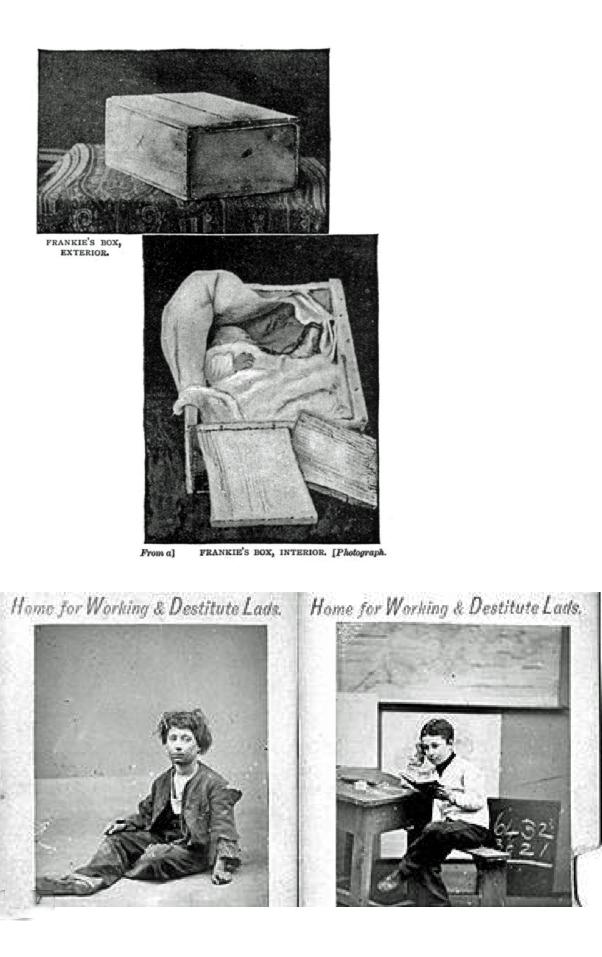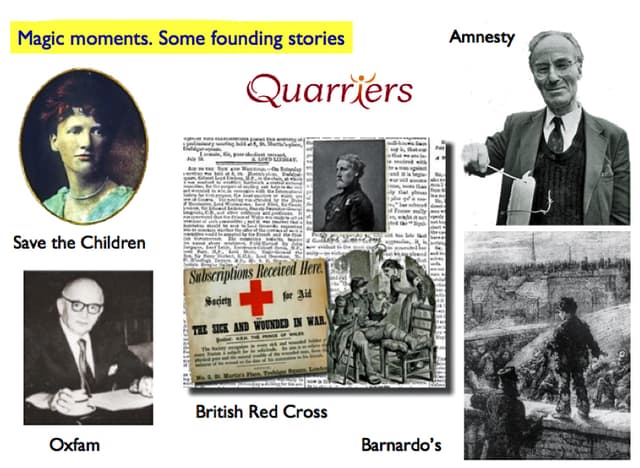Magic moments part one: how small beginnings inspire great causes
by Aline Reed and Ken Burnett
- Written by
- Aline Reed & Ken Burnett
- Added
- June 25, 2013
At the Clayton Burnett retreat on Loch Ness a few years back, Alan and Ken often attempted to take participants on their courses back in time, back to the day or even the hour before their organisation was founded. For that’s where they’ll find the fervour, zeal, anger, urgency and commitment that catalysed their organisation, that gave it impetus and momentum sufficient to get it going and keep going. Something significant happened then. If fundraisers, campaigners and communicators today can recapture the passion and emotions of that moment they’ll galvanise staff and supporters afresh, renew enthusiasm and inject new purpose into their motivation and their mission.
A good founding story, therefore, is a precious asset for any organisation. Here are just a few. But SOFII would like to add to this list.
So, what’s your story? Write today to Carolina and tell us. If it’s inspirational we’ll put in on SOFII and soon it will be inspiring fundraisers and communicators everywhere.
The British Red Cross

The tale of Colonel Robert Loyd-Lindsay’s remarkable letter to The Times of London in 1870 is told here on SOFII. His passionate plea for impartiality to the wounded of all sides struck a powerful chord with the British people and raised the equivalent of £17 million in initial gifts – not bad for one letter. Thus was started the British Red Cross Society.
Barnardo’s

In 1867, Dr Thomas Barnardo set up a ragged school in the East End to give poor children a basic education. One cold, winter’s night the boy called Jim Jarvis stayed behind and seemed reluctant to go ‘home’. Jim told Barnardo that he had no home and offered to show Barnardo round the streets of the East End. That night, Jim and Barnardo climbed over a brick wall. They saw 11 boys, aged nine to 11, huddled together in the open, sleeping rough. Dr Barnardo was shocked and realised that he needed to provide homes for children too. He even wrote to the Prime Minister about his meeting with Jim, asking him for a donation!
Dr Barnardo opened his first refuge for boys in 1870. The house was soon full of homeless children – so much so that one night, staff were forced to turn away an 11-year-old boy called John Somers, nicknamed ‘Carrots’. Two days later little Carrots was found dead. From then on, Barnardo’s homes displayed this sign: no destitute child ever refused admission.
The Story of Frank – a child in a box
‘Few children reach Dr. Barnardo whose antecedents cannot be traced and their history recorded in the volumes kept for this purpose. But Frankie remains one of the unknown. Some time ago a carrier delivered what was presumably a box of Swiss milk at the Homes.
‘The porter in charge received it, and was about to place it amongst other packages, when the faintest possible cry escaped through the cracks in the lid. The pliers were hastily brought, the nails flew out, the lid came off, and there lay little Frank in his diminutive baby's robe, peacefully sleeping, with the end of the tube communicating with his bottle of milk still between his lips!’
Dr Barnardo’s midnight guided tour of the rooftops of London’s notorious Whitechapel district courtesy of young vagrant Jim Jarvis is already documented on SOFII, as is the good doctor’s remorse at the death of ‘Carrots’, the boy he had turned away because his new home was full and whose death led to the policy of ‘an ever-open door’.
Save the Children Fund

Post-first world war famine and Eglantyne Jebb’s visions and dreams were the spur that compelled her to found Save the Children in London in 1919.
‘The children's bones were like rubber. Clothing was utterly lacking. In the hospitals there was nothing but paper bandages.’—Dr Hector Munro, Save the Children, 1919
This suffering alone was sufficient incentive to start a new organisation dedicated to children but still SCF might never have come about had not Eglantyne, sometime during her twenties, seen a vision of Christ. It was a life-affirming experience and, in years to come, whenever she faced a challenge or a question, she would ask herself, what would Christ do?
There could be only one answer. So Save the Children was founded, an action that led directly to the International Declaration of the Rights of the Child.
Oxfam (The Oxford Committee for Famine Relief)

Cecil Jackson Cole, founder of Oxfam, Help the Aged and ActionAid, made a remarkable statement in 1945 which led to the creation of Oxfam and international aid and development organisations as we know them today. The Oxford Committee for Famine Relief was set up in 1942 purely to raise funds for the relief of the starving population in Greece, which was then occupied by the Nazis and blockaded by the British, so no food could get through. At the end of the war, their job done, the other members of the committee wanted to disband, but CJC jumped to his feet saying, ‘There is a world of need out there, we have been effective, so we must go on.’ Soon after the Committee changed its name to Oxfam, and began to change the world.
War on Want

An avalanche of postcards saying ‘yes’ led to the formation of War on Want. Outraged by the UK’s involvement in a senseless war, publisher, Victor Gollancz, sent the letter opposite to The Guardian newspaper in 1951.
He proposed a ‘great international fund should be established…for improving the conditions of those fellow human beings who, to the number of hundreds of millions, are starving, destitute and in despair’.
Gollancz asked that ‘all who are in agreement with this letter should send a postcard with just the word ‘yes’ and their name and address’.
Over the course of the next month, more than 10,000 postcards arrived.
Marie Curie Cancer Care

Marie Curie Cancer Care owes its existence to a diamond ring. Thomas Bernard Robinson OBE helped to found Marie Curie Memorial Foundation, which became known as Marie Curie Cancer Care.
Hearing of the need to raise funds, an unknown elderly woman of his acquaintance removed her diamond engagement ring and gave it to him to auction. It made £75, equivalent to over £5,000 today.
According to his son, Robinson used the proceeds to fund…a mailing, which gave Marie Curie Cancer Care its first supporters.
St Dunstan’s (Blind Veterans UK)
Arthur Pearson was a newspaper owner – in 1900, he set up the Daily Express. A few years later, he bought theEvening Standard. Soon after, he started to lose his sight.
During the First World War, Pearson (by then blind) was horrified to find there was no care available for soldiers who had been blinded. He founded St Dunstan’s (now Blind Veterans UK) with the radical idea of offering blind servicemen the chance to gain vocational skills so they could earn a living.
Arthur Pearson would visit the bedside of newly blinded servicemen with the aim of helping them ‘learn to be blind’. He gave each one a Braille watch, explaining to them that by feeling the raised dots he could tell the time. For many servicemen, this one act changed their outlook and the practice continues to this day. Current president, Ray Hazan, explains:
‘In a tradition started by our founder, Sir Arthur Pearson, a visitor came to my bedside and asked me the time. This came as something of a surprise. As I’m sure you’ll understand, I’d had little idea of whether it was day or night since I’d become blind. But as he handed me a Braille watch, I learnt that I could still tell the time.
‘Psychologically, that was so important. My negative thoughts were driven away. And I began a new journey – living my life again as a blind man, yes, but as one who no longer thought constantly about what he couldn’t do, but about what he could do.’
The Art Fund, UK

This story concerns not so much the formation of the Art Fund, but the secret behind one of its first public appeals – and a mystery benefactor.
In 1909, the then chairman of The Art Fund, Lord Balcarres, learned he had less than a month to raise the £72,000 needed to keep Hans Holbein’s portrait of Christina of Denmark, Duchess of Milan from being sold to an American buyer. The chairman wasted no time launching one of the Art Fund’s first-ever public appeals for donations. But sadly, as the deadline approached ever more quickly, it was beginning to look like this treasured painting would be lost forever.
Then, with just 48 hours to go, the chairman received a wire transfer for £40,000 from an English woman holidaying at a German spa. The Art Fund was shocked by the incredible generosity of the donor, but there was one further surprise to come. These crucial funds – the exact amount still needed to save Christina of Denmark – had been offered only on the condition that the name of the donor never be revealed.
And so, to this day, the mystery woman’s identity is kept sealed in an envelope, annotated with the words, ‘To be opened by one without scruples’.
The envelope has been passed, unopened, from each chairman of the Art Fund to the next for over one hundred years. Inside it is the secret to one of our earliest and greatest campaigns.
Amnesty International
London lawyer Peter Benenson was travelling on the London Underground in November 1970 when he read of two young men in Portugal being imprisoned for seven years merely for raising a toast to freedom. He was so incensed that he wrote an impassioned article for The Observer about the summary denial of human rights, and thus Amnesty International was born. Peter Benensen adopted the symbol of a candle wreathed in barbed wire. He said,
‘The candle burns not for us, but for all those whom we failed to rescue from prison, who were shot on the way to prison, who were tortured, who were kidnapped, who “disappeared”. That’s what the candle is for.’
The candle still burns today.
According to Aline, legend has it that Amnesty has an actual candle that’s passed from CEO to CEO. We are checking on that story in the hope of verifying it, but what a great story! Even if it isn’t true, it should be.
And that’s our point. It can be, so easily. And we can all pass on that symbolic candle to succeeding generations. Founding moments are too important to be consigned to the dustbin of history. There’s still a lot of inspiring for them to do. That’s why we should all search out, preserve and celebrate magic founding moments.
To come: more magic founding moments from Greenpeace, NSPCC, SPANA, YMCA, Great Ormond Street Children’s Hospital, Centrepoint….and any that you care to point us towards. In particular, we recognise that our first listing, perhaps inevitably, is very British in its composition. But we know that other countries have organisations whose founding moments are just as inspirational. So please, send them in and share them with the world.


Outrageous fundraising: Dr Barnardo sold ‘before’ and ‘after’ photos of the boys who were cared for at Stepney Boys’ Home. The cards were sold for 6d each or five shillings for packs of 20. This practice continued for 30 years, from 1874 onwards. The good doctor is quoted as saying,
‘A photo is taken of every child when it arrives—even in tatters; it is re-photographed again when it is altogether a different small creature.’
Dr Barnardo regularly told people he was running out of money, to get in emergency funds. He died owing a lot of money.
See also Magic Moments part 2: how some of the world’s best causes got started.
And Magic Moments: the founding of North London Cares and the Cripplegate Foundation.
© Aline Reed and Ken Burnett 2012



















